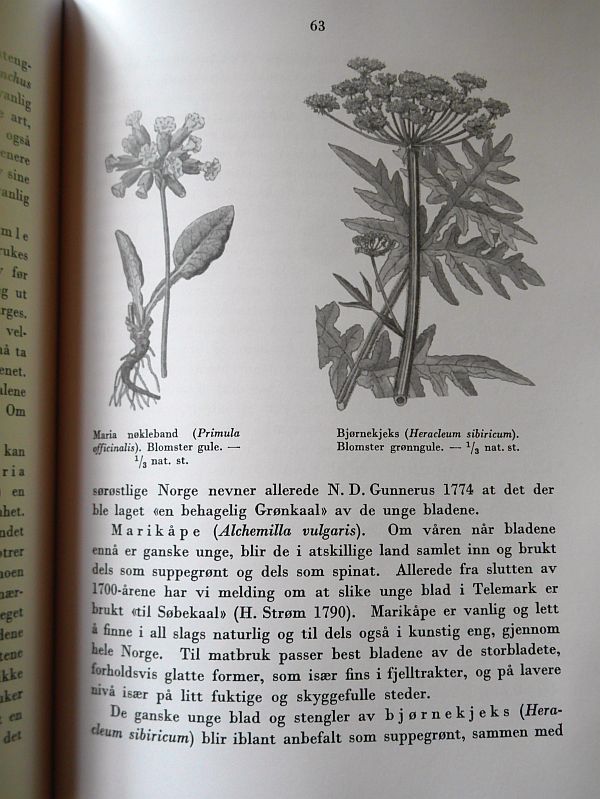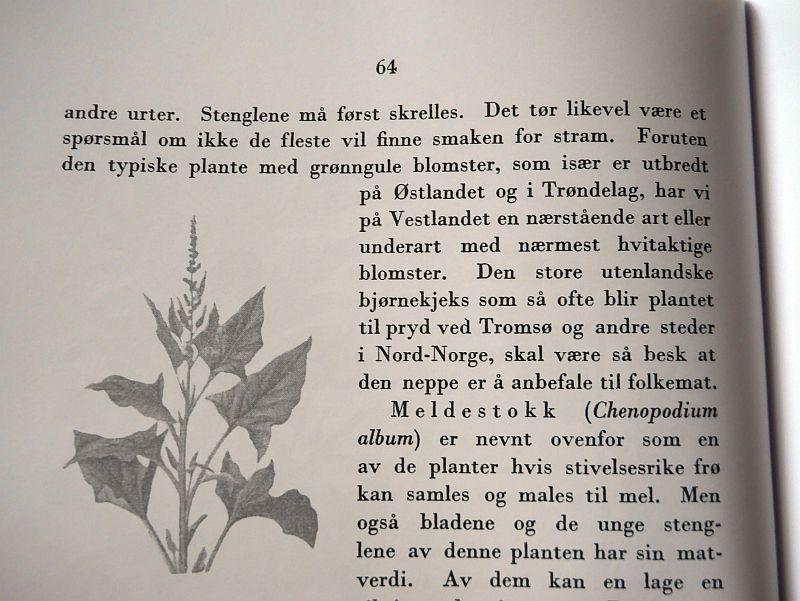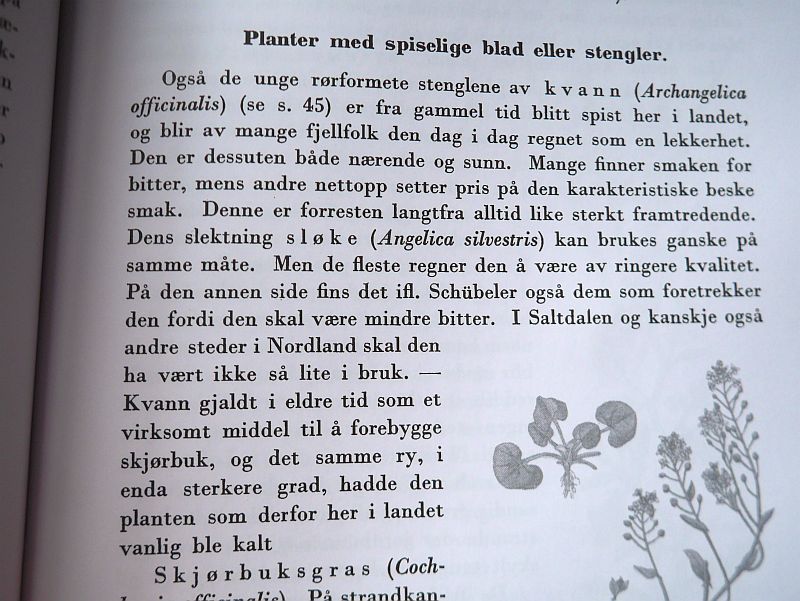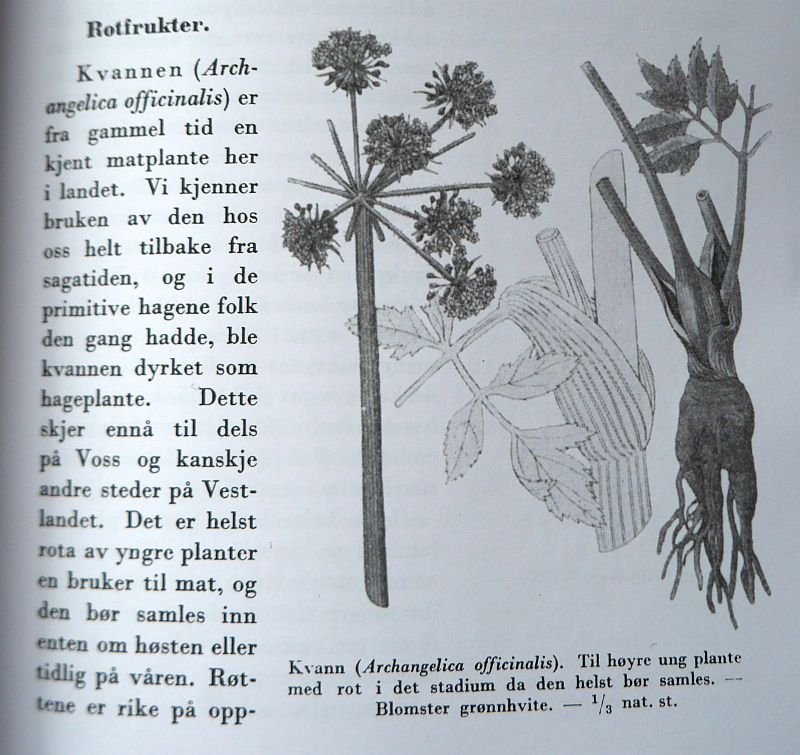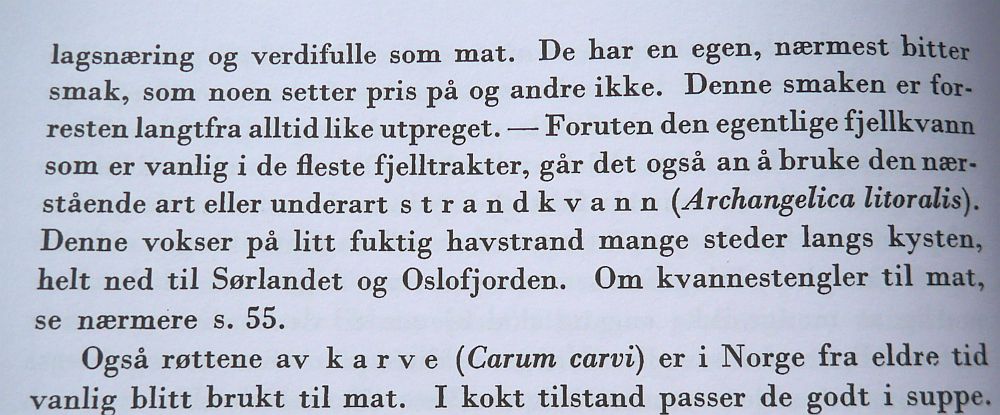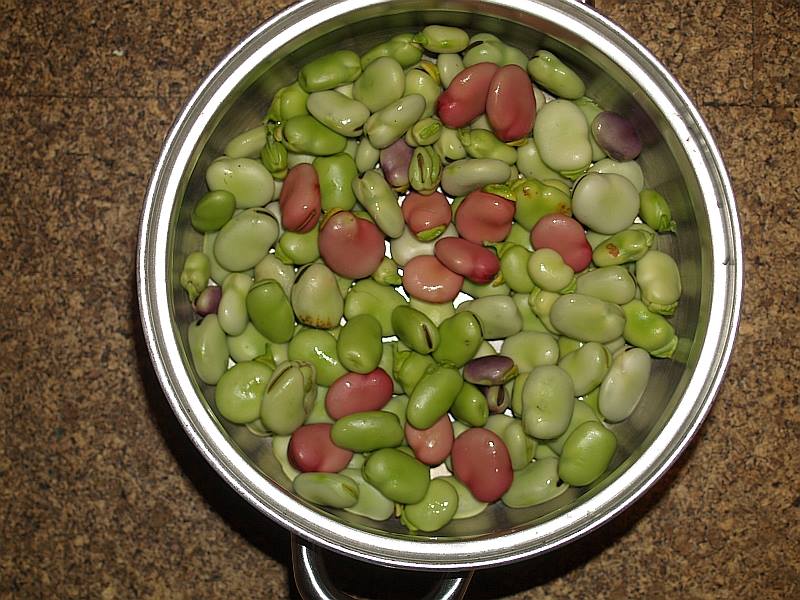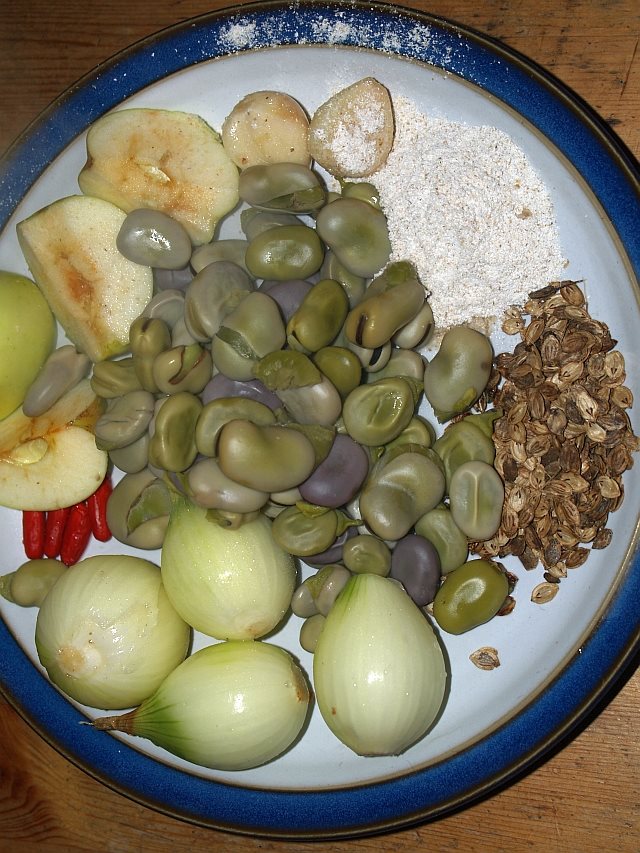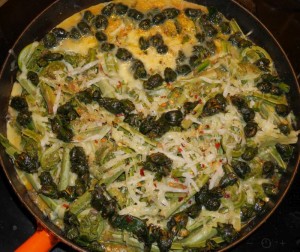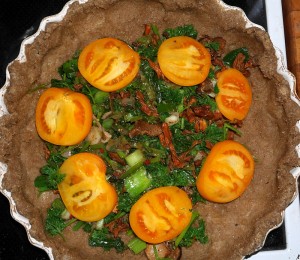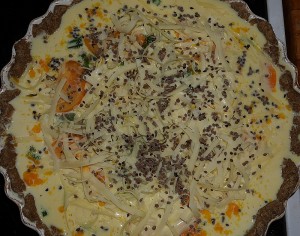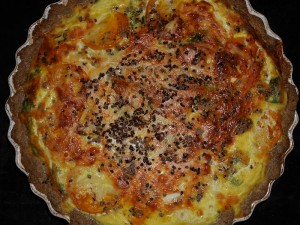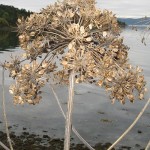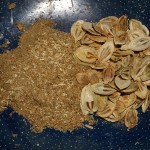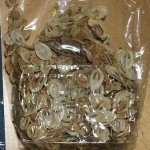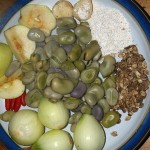Falafels can be home grown over most of Norway and if we are serious about climate change should become standar fare in kitchens, restaurants and supermarkets throughout the country. Dig for VICTORY against climate change!
The ingredients:
Broad beans / fava beans (bondebønner); grown in Malvik and stored dried
Victory onion (seiersløk) grows particularly well in the arctic (or replace with garlic or ramsons)
Golpar (spice from ground seed of any member of the Heracleum genus, including invasive Tromsøpalme, Heracleum persicum)
Barley flour (bygg) – I used100% whole grain
Eggs to bind
Fry in oil (sorry, I used imported olive oil)
(Optional: house grown chilis)
Decoration: Oxalis triangularis


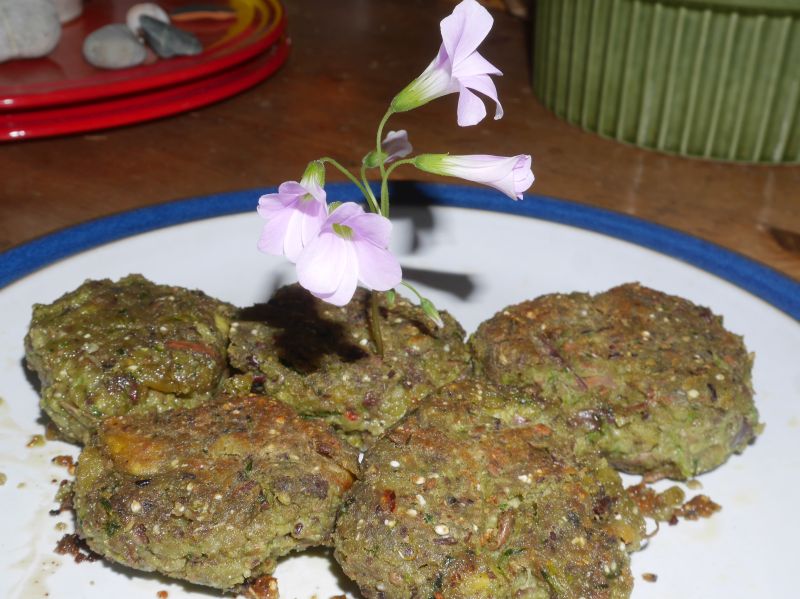
Tag Archives: heracleum persicum
Golpar ready to use
- Cleaned this year’s golpar harvest, my favourite spice…used in a range of dishes, see here: http://www.edimentals.com/blog/?s=golpar
Real golpar is the ground seed of Heracleum persicum (Tromsøpalme), an important spice in Iran. I use a mix of wild and cultivated species of Heracleum (hogweeds): H. sibiricum, H. maximum, H. sphondylium…and naturalised H. persicum

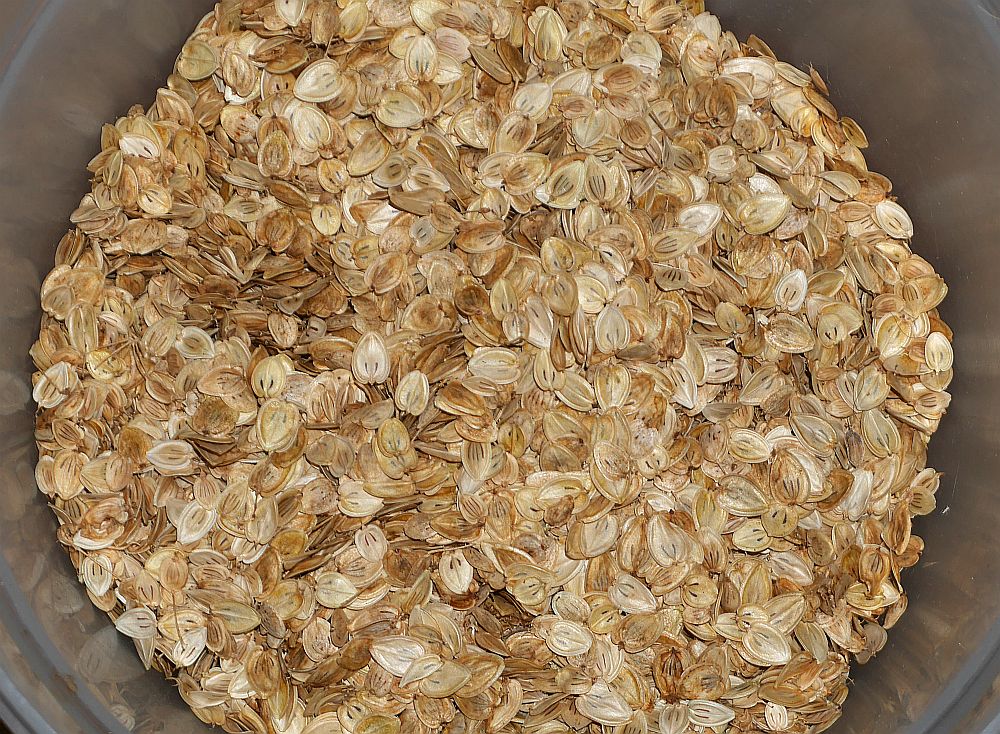
Holmboe’s Gratis mat av ville planter
Jens Holmboe’s book “Gratis mat av ville planter” (Free food from wild plants) from 1941 is still my favourite Norwegian book on wild food as it is well researched and includes a number of interesting anecdotes. I’ve had a photocopy of the whole book for many years (I think I borrowed it from my friend Jan Erik Kofoed and copied it at work in the 1980s). I finally own a copy of the book from the 2016 reprint! It had somehow passed me by that it was available! Thanks to Hanne Edvardsen from Trondheim Nyttevekstforening who gave me a copy at the recent Ringve Botanical Garden Open Day!
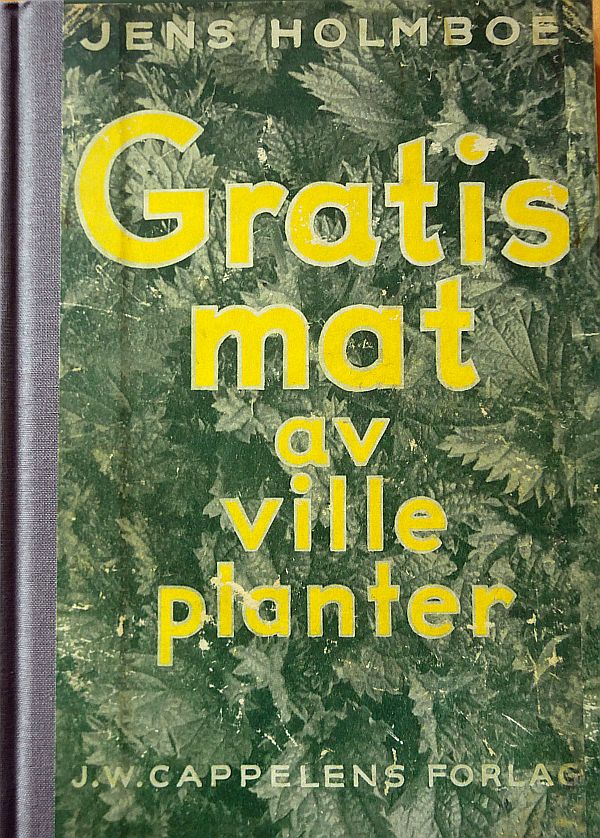
Interestingly, it does include the hogweeds / bjørnekjeks (Heracleum) including giant Tromsøpalme (Heracleum persicum, source of the spice golpar and a vegetable in Iran). However, I don’t think he could have tasted the latter when he wrote: “….skal være så besk at den neppe er å anbefale til folkemat” (…is apparently so bitter that it can hardly be recommended as food). Similarly, he mentions that Heracleum sibiricum is sometimes recommended for soups , together with other herbs….and it is likely to be too strong tasting for most people.
He writes about kvann (Angelica archangelica) as a wel known food plant in Norway right back to the time of the Vikings. He talks about it still being cultivated in Voss (and perhaps other places in western Norway). He encourages the use of roots as a nutritous food and indicates that some people like their bitter taste, others not. Unlike some books he also says that the subspecies litoralis (found on the coast of Norway) can also be used. He also says that Angelica sylvestris is much used in northern Norway and that it is less bitter!
Buy the book for kr. 250 plus postage by ordering through
sbarstow2@gmail.com
Payment either by Paypal, bank transfer or VIPPS (Norway). Please remember your address!
30 years in Norway salad
https://bentehaarstad.photoshelter.com/gallery/Edible-plants-Stephen-Barstows-garden/G0000yLcSVBDTqqI
Bjørg Hernes from local paper Malvikbladet wrote an article about the event which included a salad made with (only) 30 edibles to commemorate my 30 year anniversary of veggie growing in Malvik!
This was also the event when Saideh, originally from Iran surprised us all telling us that she ate naturalised invasive Tromsøpalme (Heracleum persicum) collected in the centre of Trondheim…this encounter was later related in my book and Saideh kindly provided recipes!
Below the pictures is a list of ingredients!
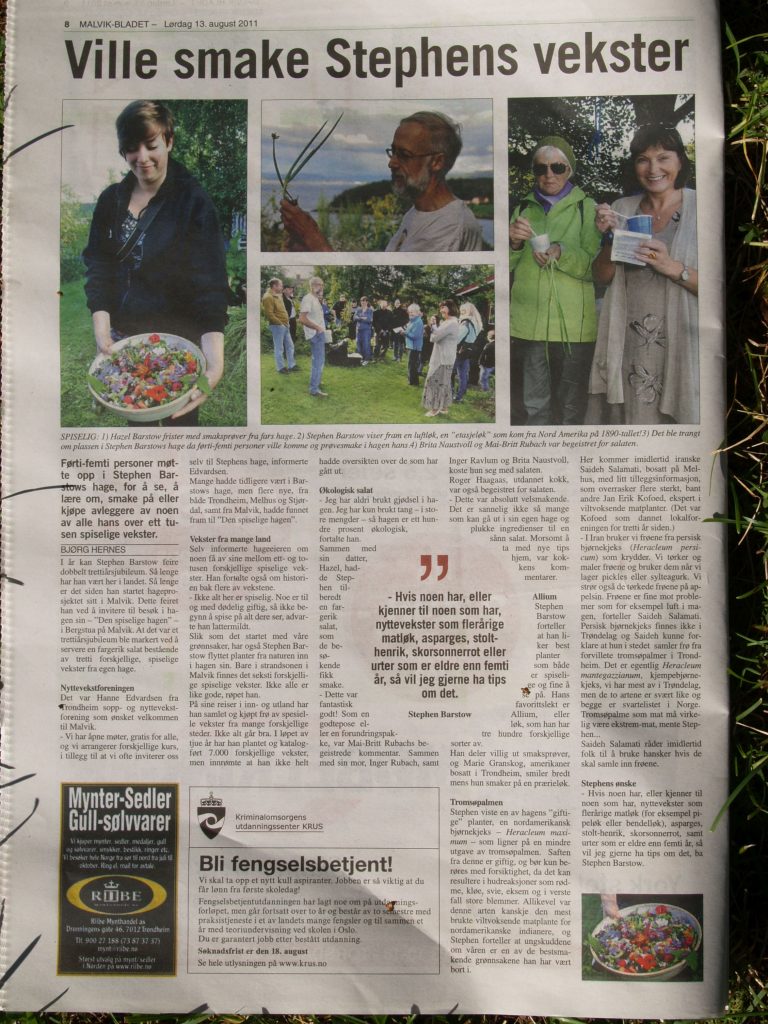
List of ingredients:
- Adenophora Ex- Amethyst (blomst);Ladybells;
- Aegopodium podagraria;Ground Elder;Skvallerkål
- Agastache anisata (blomst);Anise Hyssop;Anisisop
- Agastache anisata alba (blomst);Anise Hyssop;Anisisop
- Allium cepa #1;Salad Onion;Vårløk
- Allium cepa #2;Salad Onion;Vårløk
- Allium fistulosum “Svenskelauk”;Welsh Onion;Pipeløk
- Allium fistulosum #1;Salad Onion;Vårløk
- Allium fistulosum #2;Salad Onion;Vårløk
- Allium flavum (blomst);Small Yellow Onion;Doggløk
- Allium nutans “Lena” (Slizun) ;Blue Chives;Sibirsk nikkeløk
- Anthriscus cerefolium;Chervil;Kjørvel
- Apium graveolens #1;Celery;Selleri
- Apium graveolens #2;Celery;Selleri
- Artemisia dracunculus sativa;French Tarragon;Fransk estragon
- Atriplex hortensis rubra;Orach;Rød hagemelde
- Borago officinalis (blomst); Borage;Agurkurt
- Borago officinalis alba (blomst); Borage;Agurkurt
- Brassica oleracea var sabellica;Kale;Grønnkål
- Calendula officinalis (blomst);Pot Marigold;Ringblomst
- Chenopodium album “Magenta”;Lamb’s Quarters;Meldestokk
- Cichorium intybus #1;Chicory;Sikkori
- Cichorium intybus #2;Chicory;Sikkori
- Cichorium intybus (blomst);Chicory;Sikkori
- Commelina coelestis (blomst);Blue Spider Wort;Knollhimmelblomst/Dagblomst
- Commelina coelestis alba (blomst);Blue Spider Wort;Knollhimmelblomst/Dagblomst
- Cryptotaenia japonica atropurpurea;Mitsuba; Japanese Parsley;Mitsuba; Japansk Persille
- Cucurbita pepo pepo (blomst);Courgette/Zucchini;Zucchini/ Squash
- Daucus carota #1;Wild Carrot;Gulrot
- Daucus carota #2;Wild Carrot;Gulrot
- Diplotaxis tenuifolia;Perennial Wall Rocket;Steinsennep/Flerårige Rucola
- Fedia cornucopiae;African Valerian;Afrikanskvendelrot
- Hablitzia tamnoides;Hablitzia;Stjernemelde; Kaukasisk Spinat
- Hemerocallis #1 (blomst);Day Lily;Daglilje
- Hemerocallis #2 (blomst);Day Lily;Daglilje
- Hosta ventricosa (blomst);Hosta ;Bladlilje/Hosta
- Impatiens glandulifera (frø);Jewelweed/Himalayan Balsam;Prydspringfrø
- Lactuca sativa #1;Lettuce; Salat
- Lactuca sativa #2;Lettuce; Salat
- Lactuca sativa #3;Lettuce; Salat
- Lycopersicon esculentum ; Tomato;Tomat
- Malva crispa;Salad Mallow;Kruskattost
- Malva moschata;Musk Mallow;Moskuskattost
- Malva moschata alba;Musk Mallow;Moskuskattost
- Malva sylvestris mauritanica;Common Mallow;Apotekerkattost
- Mentha aquatica (blomst);Water Mint;Vassmynte
- Monarda didyma “Adam” (blomst);Bee Balm, Bergamot,Oswego Tea;Vanlig hestemynte; Etasjeblomst
- Nasturtium officinale;Watercress;Grønn engelskkarse
- Petroselinum crispum;Parsley;Persille
- Phaseolus vulgaris;Bush Bean;Hagebønne
- Pisum sativum “Purple Podded”;Pea;Hage/Sukkerert
- Pisum sativum #4;Pea;Hage/Sukkerert
- Pisum sativum #5;Pea;Hage/Sukkerert
- Pisum sativum “Golden Sweet” ;Pea;Hage/Sukkerert
- Pisum sativum “Sugar Snap” ;Pea;Hage/Sukkerert
- Raphanus sativus (umodne frøkapsler);Radish;Reddik
- Rubus idaeus #1;Raspberry;Gulbringebær
- Rubus idaeus #2;Raspberry;Gulbringebær
- Rubus idaeus “Aprikos”;Raspberry;Gulbringebær
- Rubus idaeus “Gul”;Raspberry;Gulbringebær
- Rumex acetosa ;Sorrel;Engsyre
- Rumex scutatus;Buckler-leaved Sorrel;Fransksyre
- Sonchus oleraceus;Common Sow-Thistle;Haredylle
- Talinum paniculatum;Pink baby-breath;
- Taraxacum pseudoroseum;;Rosaløvetann
- Taraxacum variegatum ;Variegated Dandelion ;Broketbladet løvetann
- Tropaeolum majus (blomst);Nasturtium;Vanlig blomkarse
- Valerianella locusta ;Cornsalad; Lamb’s Lettuce;Vårsalat
- Vicia faba;Broad Beans;Bondebønne
46 botaniske arter; 69 sorter
19th October 2014 Falafel
OstrichDandyHeartOmelette
Golpared onion bhajis
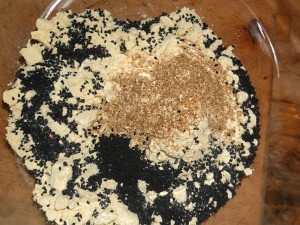
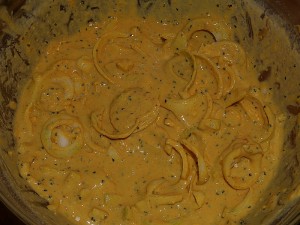
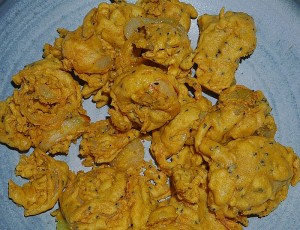
Indian bhajis are a popular snack or side dish in UK Indian restaurants…deep fried onions in a batter made of chick pea flour with various spices usually including cumin, coriander, black onion seed or kalonji (Nigella sativa), I replaced the cumin with golpar (ground seed of Heracleum persicum collected from a wild stand in Trondheim)! Delicious!
P.S: Mental note: try with broad bean flour!
Invasive Moonglow Quiche
The pie crust was made of whole grain fine naked barley flour (Hordeum vulgare var. nudum).
Harvesting golpar
The seed is used as an important spice in Iran, something I learned from my friend Saideh Salamati who I credited in my book (she also made an excellent dish of the young shoots at a gathering of foragers here in June). I nowadays use more golpar in my cooking than any other spice…delicious and free!

